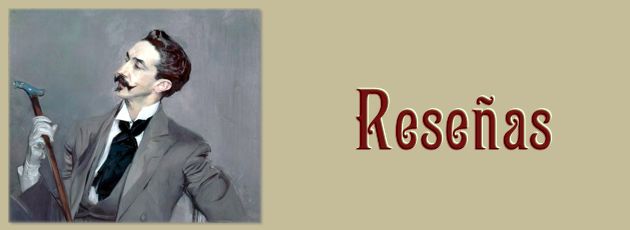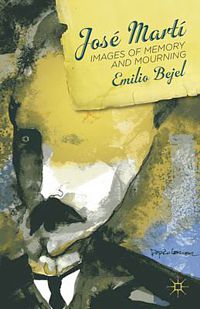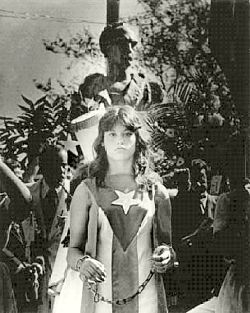
José Martí. Images of Memory and Mourning
Bejel, Emilio; New York: Palgrave/Macmillan, 2012
Oscar Montero, CUNY
 Images of Martí, early photographs, the sculptures and busts in every Cuban park, hagiographic and parodic paintings, films, do not suggest the elegant order of a museum but rather constitute a strange labyrinth where generations of school children, demagogues, scholars, critics and artists of every stripe have lost and sometimes found their way. “Memory” and “mourning,” sparked by some of these images, are the main topics of Emilio Bejel’s brief, intense book, which is both the rather muted personal narrative of the exiled Cuban scholar and a tentative yet ambitious cultural, political project to “resignify” Martí through the many images of him that were produced during his life, throughout the last century, up to today. The personal and the political, it goes without saying, define a complex territory, diversely mapped, requiring a wide range of styles, poses and strategies. Bejel travels through it cautiously, in a self-effacing manner that still hints at the strong emotions that underlie what is in a sense a personal pilgrimage through this labyrinth of images.
Images of Martí, early photographs, the sculptures and busts in every Cuban park, hagiographic and parodic paintings, films, do not suggest the elegant order of a museum but rather constitute a strange labyrinth where generations of school children, demagogues, scholars, critics and artists of every stripe have lost and sometimes found their way. “Memory” and “mourning,” sparked by some of these images, are the main topics of Emilio Bejel’s brief, intense book, which is both the rather muted personal narrative of the exiled Cuban scholar and a tentative yet ambitious cultural, political project to “resignify” Martí through the many images of him that were produced during his life, throughout the last century, up to today. The personal and the political, it goes without saying, define a complex territory, diversely mapped, requiring a wide range of styles, poses and strategies. Bejel travels through it cautiously, in a self-effacing manner that still hints at the strong emotions that underlie what is in a sense a personal pilgrimage through this labyrinth of images.
In the United States, the name of José Martí may be known as the Cuban “poet-revolutionary” and little else; however, not just among Cubans but everywhere that Spanish is spoken, Martí is a recognizable icon. In Diego Rivera’s “Sueño de una tarde dominical en la Alameda Central,” packed with images from Mexican history, Martí occupies a privileged spot, just to the right of Frida Kahlo and behind the young Diego. Some of Martí’s works are among the most widely known in the Spanish language; one need only mention the enduringly popular Versos sencillos and essays anthologized dozens if not hundreds of time -- for example, “Our America,” “My Race,” “Coney Island” and many others. Bejel, however, focuses on Martí’s visual or more precisely his representational legacy, photographs, paintings, busts, monuments and films. Bejel spells out his theoretical sources, Benjamin, Barthes, Freud among them, and incorporates them into his arguments. Nevertheless, to summarize these arguments is to simplify a narrative that works through a process that oscillates from close readings of visual texts to theoretical reflections to personal asides. In brief, I believe that Bejel is asking himself and his readers: what happens when one looks at a photograph, a statue, a painting, a film of/about Martí? What happens of course depends on the individual who is looking, one might argue, but one of Bejel’s recurring points is precisely that such an idealized subjectivity is a convenient chimera, because by looking at an image of Martí, the viewer becomes part of a community, a community with a long history, with narrative strands whose common denominators are “memory and mourning.” The image of the dead hero revives his memory and at the same time recalls his loss, not only his death but the failure of the very ideals he cherished and framed in a founding gesture that signified both the finality of sacrifice and the promise of a new origin, a promise if not altogether lost, certainly deformed since the early years of the Cuban republic.
Throughout the book Bejel restates his claim for a memory and a mourning that may transcend loss and failure to become the source of new ways of thinking, to become the source of a new criticism, not just academic criticism, but in the sense of the work of a kritikos, one capable of judging, wisely it goes without saying. Thus from a reading of images that is in part an aesthetic enterprise, Bejel suggests a political compass for Cubans, Latinos and everyone else for that matter who has lived through the ordeals and the privileges of exile and who has inherited the rancid dualisms of superseded political polarizations, among them, revolution vs. imperialism, their side and ours, their fortress and ours, Cuban and Cuban-American. That the history of those dichotomies, with the burden of loss and separation that they imply for many of us, is if not finished certainly in its final act, should come as no surprise to anyone capable of googling today’s news.
According to Bejel, Martí’s images came to represent both a petrified notion of national unity, literally a stone monolith in some cases, and the focus of perennial, irresoluble conflicts, a political, moral and aesthetic spinning of wheels. Monuments to Martí have become the centers of empty rituals, Bejel writes, “in the service of national amnesia.” His goal then is to “resignify” the image not to dismiss it as superseded or politically flawed on the one hand; or as a kind of aesthetic fetish, on the other. His goal is rather “to incorporate and develop out of Martí’s circulating images a critical strategy opening and rescuing the contingencies enclosed in these representations” (119).
The chasm between artistic production and political action long associated with modernismo, one of whose unquestionable origins is the work of Martí, was largely the creation of scholars and critics who transformed some salient literary themes into a rather rigid formula. In fact, “Art for art’s sake,” a sound bite that made the rounds in the cafés of nineteenth century Paris, never made sense in Latin America, and not a single one of the first-ranked modernistas took it at face value, even if the idea certainly appeared in various guises in their works. At the same time, critics and scholars of modernismo often took pains to point out that Martí was the exception to the now almost quaint dichotomy of art vs. politics; nevertheless, a division of labor regarding his poetic vs. his political work persisted.
literary themes into a rather rigid formula. In fact, “Art for art’s sake,” a sound bite that made the rounds in the cafés of nineteenth century Paris, never made sense in Latin America, and not a single one of the first-ranked modernistas took it at face value, even if the idea certainly appeared in various guises in their works. At the same time, critics and scholars of modernismo often took pains to point out that Martí was the exception to the now almost quaint dichotomy of art vs. politics; nevertheless, a division of labor regarding his poetic vs. his political work persisted.
In his book Bejel sidesteps rigid political/aesthetic dichotomies in order to focus on a series of images that may suggest more nuanced points of view. In the first photograph of the young Martí, the nine year-old boy looks so intensely at us that the image seems to dissolve into a single eye; then there is Martí the prisoner, an oddly posed photograph of Martí in chains, later transformed into a sculpture that turns the young, and rather frail, prisoner into a strapping, classically posed young revolutionary, suggesting a none too subtle link between Martí and the young rebels that brought about the triumph of the Cuban Revolution in 1959, a link of course that is one of the pillars of its rhetoric.
As if to balance the impact of these revolutionary images, Bejel then focuses on a photograph of Martí as a dandy during his exile in Spain; in other photographs, Martí appears as a smiling father, a thoughtful leader, and finally as a rotting corpse. Martí seems to be playing different roles in some of these photos, yet they remain close to the body they represent: the photograph of his partly decomposed head concludes this narrative, affirming his martyrdom while mourning his death. Bejel suggests that the photographs enact a narrative of promise and loss, which contrasts with the many statues of Martí, from Havana, to Miami to New York’s Central Park; the statues are less the representation of a body than ideological constructions that responded to circumstances and events from the period when they were created. With the passing of time, the distancing or near erasure of that ideological baggage has silenced the marble or bronze image, resulting in a mute monolith devoid of meaning, or worse, capable of sustaining contradictory meanings, for many years the source of sterile shouting matches or worse.
In film and the visuals arts of recent years, the image of Martí is parodied, “desacralized,” and at times rescued, forced to make sense anew, different kinds of sense. In the end, Bejel affirms, the image triumphs precisely because it is “heterogeneous and polyvalent,” because its capacity to question established traditions is open to constant renewal. It is such a renewal that Bejel seeks, as a critic, as a citizen. Bejel’s book deftly covers this complex territory in a valiant effort, he writes, “to rethink and resignify Martí,” which he suggests might require that we rethink and resignify ourselves, no easy task to be sure, but José Martí. Images of Memory and Mourning leaves a lucid record of the journey and suggests its possible, necessary sequels.
New York, N.Y.
January 28, 2013

